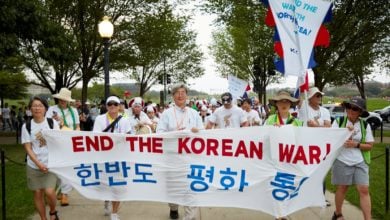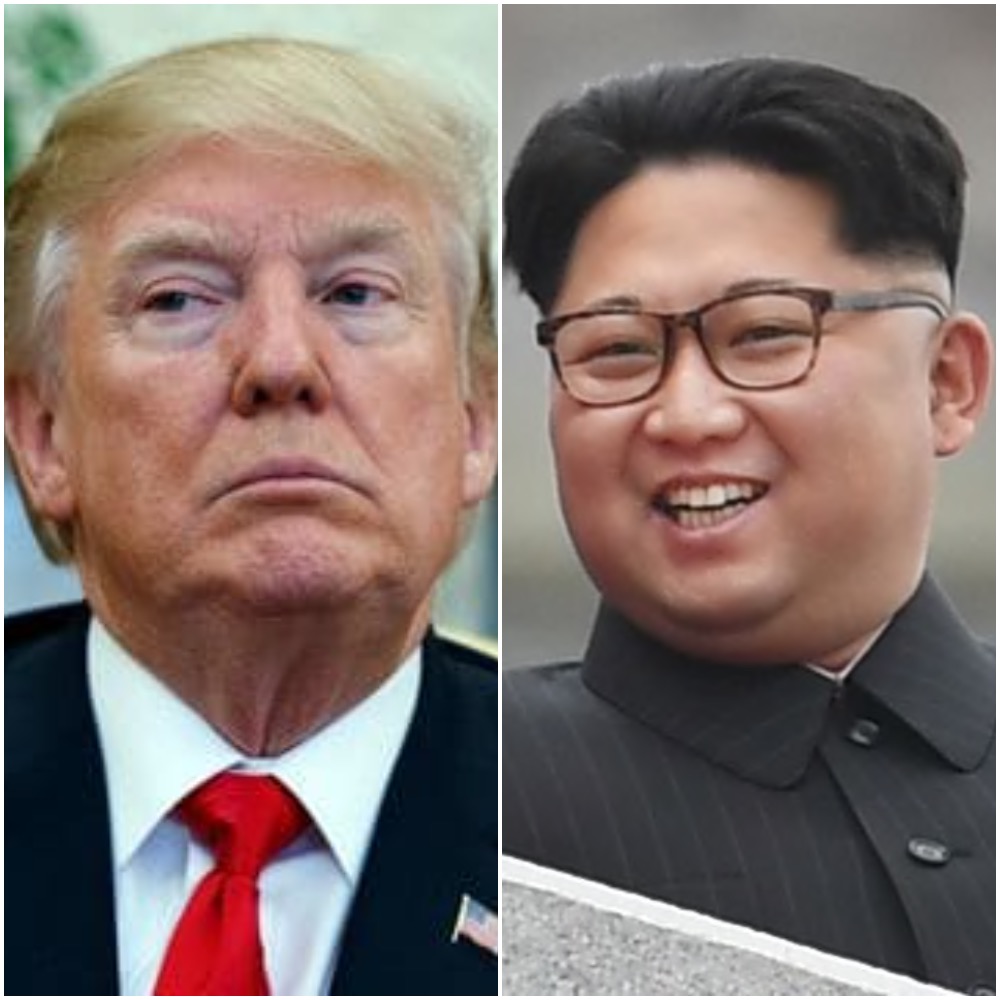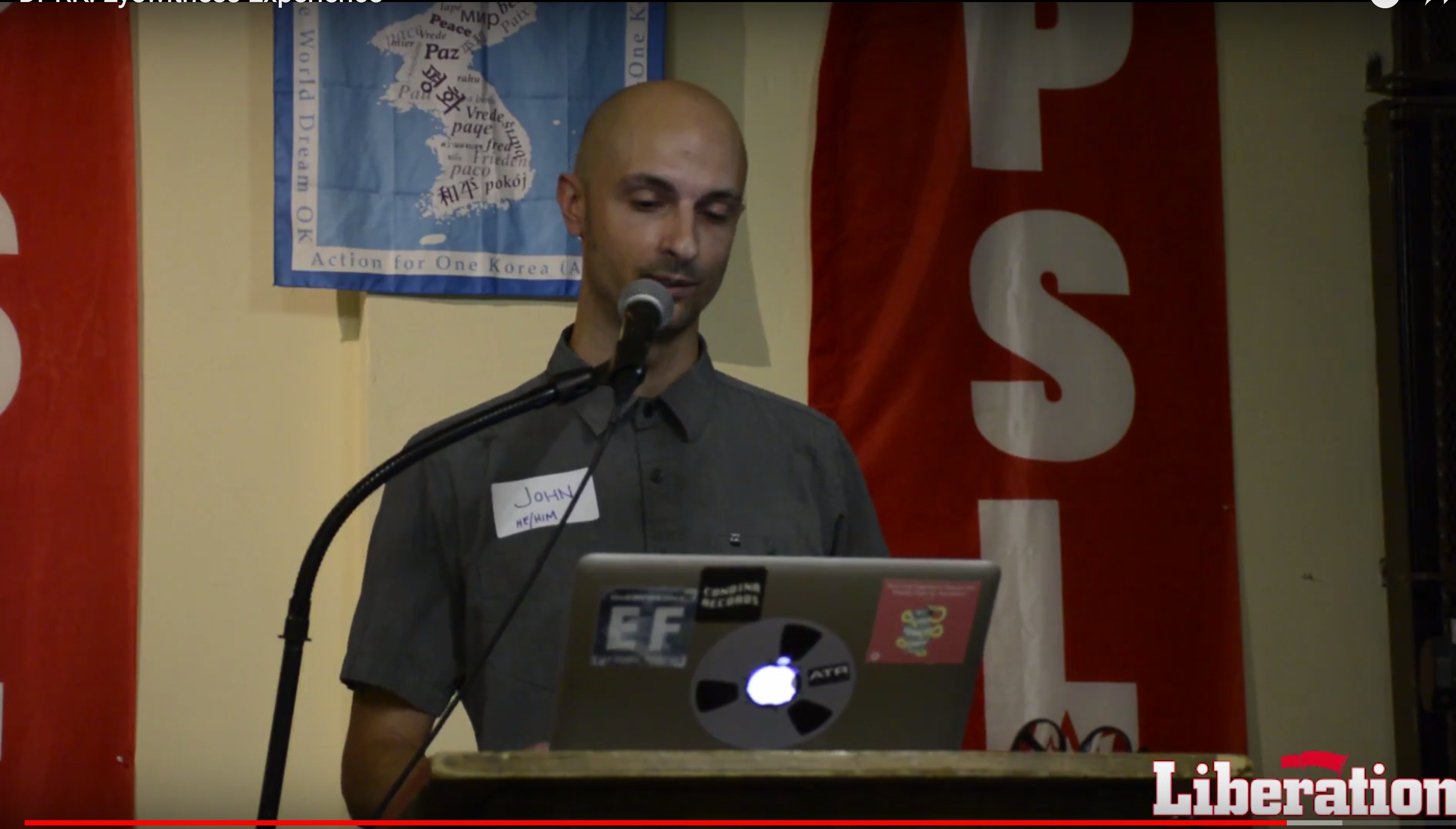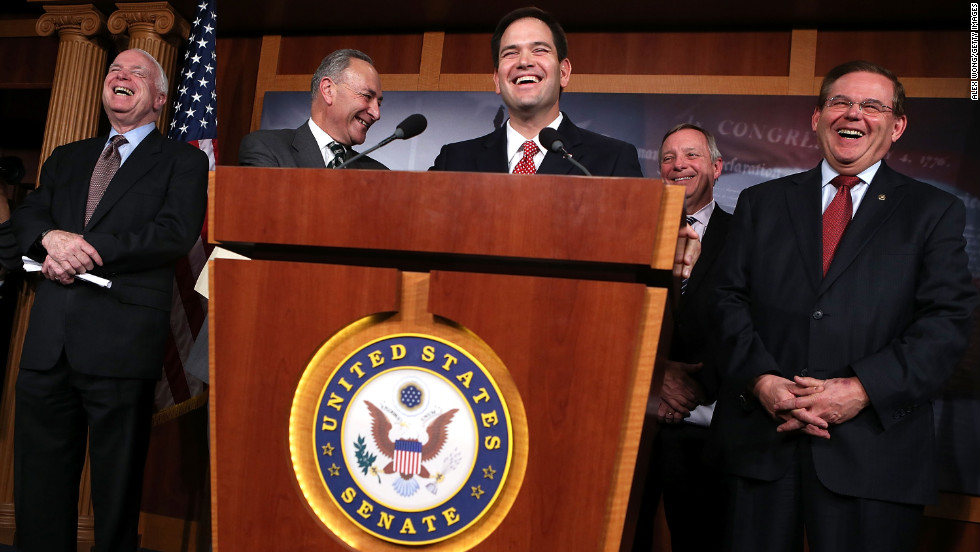Korea is one. … Through these years under the divided sky and land, tree rings of the people’s suffering were etched and a whole new generation of people grew up. But who is to say he can slice a stream of water into two? Who is to say he can split the sky into two? Korea, which lived as one land through the 5,000 years of its history inheriting a single line of blood, is one.
—Pyongyang Times, July 15, 1972
 |
Korea has existed for many millennia. This history makes it clear that Korea is one country that has been cruelly divided by U.S. imperialism since 1945.
As a result of this division, the economic, social and political development of the two Koreas in the post-colonial era took entirely different paths.
The division of the Korean peninsula
Japan ruled Korea as a colony beginning at the end of the 19th century. This colonialism sparked fierce resistance throughout the country.
The terms of Japan’s surrender in Korea at the end of World War II were based on an agreement between the United States and the Soviet Union. Korea was to be temporarily divided into two zones at the 38th parallel. Japan would surrender to Soviet troops in the north and to U.S. troops in the south.
North of the 38th parallel, where Soviet troops were stationed, communists worked with other political forces to set up genuine self-rule. They began to construct the early stages of socialism in 1945.
South of the 38th parallel, U.S. occupying forces insisted that the defeated Japanese army remain at their posts for almost a month until U.S. troops arrived so as to prevent Korean revolutionaries from taking political power.
Korean communists resisted the partition of Korea into north and south. But when U.S.-backed forces in the south unilaterally created “South Korea,” communist forces in the north led by veteran liberation leader Kim Il Sung established the Democratic People’s Republic of Korea in September 1948. Soviet troops withdrew from North Korea three months later.
Two paths of development
North Korea is led by the Workers Party of Korea, which from its inception embodied the rule of the working class and poor peasantry. In August 1946, 50 percent of party members were poor peasants and 20 percent were workers. As party membership grew, this same relationship of class forces was maintained.
Historian Bruce Cumings, no friend of the Workers Party of Korea, notes, “Here is the microcosmic evidence of a thorough social revolution, a class structure stood on its head.”
Socialist construction in the North included rapid industrialization and increases in production. Between 1948 and 1949 alone, some industries increased their levels of production by over 50 percent.
It also included the expansion of education and literacy programs, along with other social services. By 1947, 72 percent of children were in elementary school, compared with 42 percent in 1944. There were 40,000 adult schools across the country teaching basic literacy.
Koreans in the southern half of the peninsula continued to fight for their national liberation. The Chicago Sun Times described the situation in South Korea as a “full-scale revolution, which must have involved hundreds of thousands, if not millions of people.”
Thousands of communist and nationalist political prisoners in the South were summarily executed in the spring and summer of 1950. By the time the Korean War began, U.S. and South Korean forces had killed over 100,000 Koreans in the South.
Korean War
The Korean War began on June 25, 1950. It was fought under the mandate of a U.N. resolution, but the U.S. military contributed most of the troops. The United Nations officially placed its forces under U.S. General Douglas MacArthur’s command.
The Northern communist army was initially very successful, receiving great support from the people of the South. It was widely seen as a liberating army fighting against U.S. occupation.
Communist troops swept all the way to the southern tip of the peninsula, aided by Southern partisans. But a huge infusion of U.S.-led forces pushed the Korean forces back, and reached the northern tip of the peninsula by October 1950.
Imperialist troops had now taken military control of the entire country and were contemplating crossing into China. But over 1 million Chinese volunteers crossed into Korea to fight alongside North Korean troops. They succeeded in pushing the United States back south of the 38th parallel by December 1950.
After these first six months of tremendous territorial back-and-forth, there was a military stalemate for two-and-a-half years around the 38th parallel. During this period, U.S. forces carried out a merciless bombing campaign of the North, dropping more bombs than had been dropped in all of Europe during World War II.
By 1953, no building or structure above one story still existed north of the 38th parallel. All major cities and most villages in the North were totally destroyed. On May 20, 1953, U.S. president Dwight Eisenhower authorized the use of nuclear weapons on North Korea and began the selection of targets.
Despite incredible suffering inflicted on the people of Korea, the United States could not prevail. U.S. imperialist strategists had to put their dream of conquering North Korea on hold.
A cease-fire took effect on July 27, 1953. To this day, there has never been a peace treaty. Officially, the United States is still at war with North Korea.
A Military Demarcation Line was created using the 38th parallel as a general guide. This is known today as the Demilitarized Zone. Ten million Koreans have lived in permanently divided families ever since.
 Victims of a U.S. air raid on Pyongyang, North Korea’s capital, during the Korean War.
Photo: Getty Hulton Archive
|
Post-war development
After the war, the two parts of partitioned Korea continued on the different paths of development begun in 1945.
In the North, People’s Committees—first formed in the 1940s—provided a basis for the country’s national development. From the ashes of the destruction caused by three years of war, North Korea continued its course of rapid industrialization. The economy grew at rates unprecedented throughout the world throughout the 1950s and 1960s—anywhere between 25 percent annual industrial growth according to external sources, to over 40 percent according to the North Korean government.
Enormous housing complexes rose throughout the country. Free education and health care became the reality for all.
After substantial industrial growth, in the 1970s, North Korea began the purchase of turnkey plants from Japan and Europe. Production was oriented more towards consumer goods production and importation.
The Public Health Law of the Democratic People’s Republic of Korea adopted in 1980 continued “the system of complete and universal free medical service” as a right of all in the country. All aspects of the healthcare system are free, including services, tests, treatment, medicine, travel expenses, checkups and preventive care. The health law also ensures the distribution of hospitals and clinics throughout the country.
In contrast, the South remained largely rural and poorer than the North. Beginning in the late 1960s, however, the U.S. government decided—primarily for political reasons but for economic reasons as well—to begin pumping huge amounts of capital into South Korea to build up its economy. They wanted to showcase a thriving capitalist South Korea as a counterpoint to the impressive gains made by North Korea.
The South Korean economy grew after that, except during the severe 1997 economic crisis. By 2004, South Korea was the 10th largest economy in the world. Of course, this was at the expense of the already exploited working class and peasantry, who fought battle after battle against the brutal labor codes and harsh government repression that drove the South’s growth.
Even given the very unnatural process of assisted capitalist development in the South, the economy in the North continued to thrive by comparison. In the 1970s, standards of living in the North were higher than in the South—and far more equitably distributed. The North lacked the widespread poverty and homelessness visible in the South.
In the early 1980s, the total production of electricity, coal, fertilizer, machine tools, and steel in the North were comparable or higher than in the South, though the North has half the population. According to CIA studies, per capita gross national product in the 1970s and 1980s was at the same level in the North and South. (“Korea’s Place in the Sun: A Modern History,” Bruce Cumings, 1997)
North Korea today
The economic and health situation in North Korea became catastrophic in the early 1990s. In the 1980s, the amount of available food in the country grew at a rate of 2.1 percent annually while the population grew 1.5 percent annually, meaning each year they were able to provide more food to each person. Until 1992, North Korea had a rate of undernourishment (18 percent) that was comparable to the rest of East Asia (16 percent) and better than South Asia (26 percent).
Ten years later, the percent of people undernourished had almost doubled, standing at 33 percent. This was due to the massive economic crisis that North Korea faced in the 1990s, a crisis from which their economy has only begun to recover.
In the early to mid-1990s, North Korea simultaneously faced a number of extreme objective difficulties: the loss of the Soviet Union and socialist bloc countries as trading partners, major inclement weather over several consecutive years and general agricultural problems that dramatically impacted food production. These different issues compounded one another, making a bad situation much worse.
North Korea faced a situation of food scarcity that could not be overcome by internal forces alone. Economic contraction became a major obstacle for the government’s stated goal of building socialism. After all, socialism must be based on abundance, not on scarcity.
Centralized planning and nationalized production was able to manage the scarcity and assuage the impact on the population in a way that capitalist regimes based on exploitation never could.
Centralized planning of production and the nationalized ownership of the means of production allowed important measures to be taken by the government that could not have occurred under capitalism, with private ownership of land and factories.
A United Nations Food and Agricultural Organization and World Food Program report at the end of 1996 noted: “Perhaps the most important reason that there was no wide scale famine during the year, was an effective Public Distribution System, which ensured food, albeit at much reduced levels, to the entire population. In [North] Korea, the effects of food shortages have been uniformly spread over the population and the PDS has proven itself to be a highly effective channel for food assistance.”
Deprived of capital investment, subjected to crippling financial sanctions and cut off from traditional trade partners following the collapse of the Soviet Union and the socialist bloc governments of Eastern Europe, the leadership in North Korea has experimented with new economic forms to stimulate production. In the recent years, there has been some economic improvement although nothing on the scale that the DPRK experienced between 1945 and 1990.
In North Korea, economic reforms have been made, particularly since 2002, which allow some aspects of capitalism to function within the economy. Still, what remains in the country is a fundamentally different system than what exists in the South.





